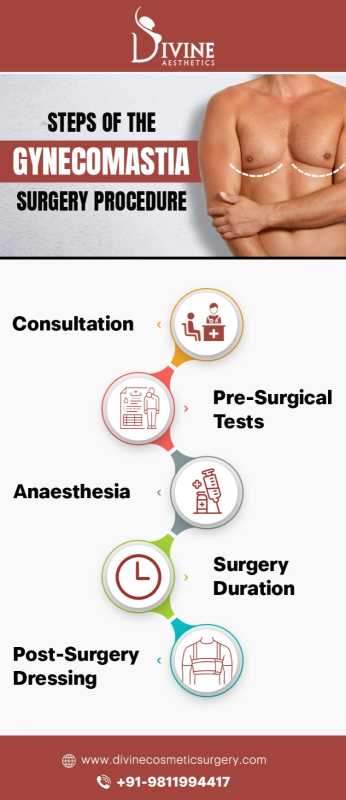What Is Gynecomastia and Why Does Surgery Matter?
If you’ve noticed unwanted enlargement in your chest area, you’re not alone. Gynecomastia is a common condition in men where breast tissue becomes enlarged due to a hormonal imbalance between estrogen and testosterone. Though it’s not physically harmful, it can be emotionally draining and impact confidence, self-esteem, and social comfort.
The good news? Surgery offers a permanent solution. In this guide, we’ll walk you through everything you need to know about gynecomastia surgery—the procedure, recovery, risks, costs, and why choosing the right surgeon matters.
What Exactly Is Gynecomastia?
Gynecomastia is the medical term for enlarged male breast tissue, caused by excess glandular tissue, fat, or both. It’s different from pseudogynecomastia, which is due to fat buildup alone, often seen in overweight individuals.
It can develop during puberty but also in adulthood due to medications, steroids, aging, or certain health issues. If it persists and affects your lifestyle or self-image, surgical treatment is usually the best solution.
Read more about Gynecomastia Grades and Types.
When Is Gynecomastia Surgery Recommended?
Not every case needs surgery. However, it’s often the best choice when:
- Gynecomastia continues beyond adolescence
- You’re emotionally distressed or self-conscious
- Non-surgical options haven’t worked
- Glandular tissue is dense and unresponsive to diet or exercise
What Happens During Gynecomastia Surgery?
Operation for gynaecomastia surgery typically involves one or more of the following:
1. Liposuction: For fat-dominant cases. Small incisions are made, and a thin tube (cannula) removes excess fat.
2. Gland Excision: Dense glandular tissue is removed through a small incision near the areola.
3. Skin Tightening (if needed): In cases with loose skin, especially after major weight loss, extra skin may be trimmed for a smoother contour.
Learn more about our advanced liposuction techniques.
Step-by-Step: The Gyno Surgery Process

Gynecomastia Surgery Procedure
Consultation: A board-certified plastic surgeon evaluates your condition, medical history, and expectations.
Pre-Op Tests: Includes blood tests and sometimes hormone evaluation.
Anaesthesia: Local anaesthesia with sedation or general anaesthesia, based on the case.
Surgery Time: 1 to 2 hours. It’s typically a same-day procedure.
Compression Garments: Worn post-surgery to reduce swelling and support healing.
What Is Recovery Like After Gyno Surgery?
- Downtime: Light activities in 2–3 days; back to work in a week
- Swelling/Bruising: Common and subsides in 2–4 weeks
- Final Results: Start becoming visible in 6–8 weeks
- Scars: Minimal and usually hidden around the areola
Is It Safe? Understanding the Risks
When performed by an experienced plastic surgeon, gynecomastia surgery is very safe. Still, minor risks include:
- Temporary swelling or bruising
- Numbness
- Slight asymmetry
- Infection (rare and manageable)
Following your surgeon’s post-op instructions significantly reduces these risks.
Why Choosing the Right Surgeon Matters
The outcome of your surgery depends heavily on the skill of your surgeon. An experienced gynecomastia surgeon will:
- Understand the emotional and physical aspects of the condition
- Customize the procedure to your body and goals
- Use modern techniques for natural-looking results with minimal scars
- Provide thorough pre- and post-op care
Meet Dr. Amit Gupta, board-certified plastic surgeon in Delhi with 20+ years of experience in gynecomastia surgery.
What Does Gynecomastia Surgery Cost in India?
Prices can vary depending on:
- The grade of gynecomastia
- Techniques used (liposuction, excision, or both)
- Surgeon’s experience and clinic location
- Anaesthesia and facility fees
Typical cost in India: ₹50,000 to ₹1,20,000
Are the Results Permanent?
Yes. Once glandular tissue is removed, it doesn’t grow back. However, maintaining a healthy lifestyle is important to prevent fat accumulation.
See the gynecomastia before and after
Who Should Avoid Surgery?
- Men with serious medical conditions (uncontrolled diabetes, heart issues)
- Those with unrealistic expectations
- Patients unwilling to follow recovery guidelines
Real Patient Experiences
Many patients report a major boost in confidence, especially when wearing fitted clothes, swimming, or going shirtless. They often say they feel like themselves again—only better.
Watch our Real Patient Testimonials.
Frequently Asked Questions (FAQs)
Q: Is gynecomastia surgery covered by insurance?
A: Usually not, as it’s considered a cosmetic procedure unless linked to a medical condition.
Q: What is the success rate of the surgery?
A: Gynecomastia surgery has a high success rate of over 95% when performed by an experienced surgeon.
Q: How do I prepare for the surgery?
A: Stop smoking, avoid blood thinners, undergo necessary tests, and follow your surgeon’s pre-op instructions.
Q: Are EMI or financing options available?
A: Yes, Divine Cosmetic Surgery offer easy EMI and flexible financing options.
Conclusion: Regain Confidence, Not Just a Flat Chest
Gynecomastia may not be life-threatening, but it can deeply affect your quality of life. Surgery offers a safe, lasting solution—especially in expert hands.
Are you ready to take the first step toward confidence?
👉 Book a Free Consultation with our board-certified gynecomastia experts today and discover your best options.
📥 Prefer a handy summary? Download Gynecomastia E Book PDF











